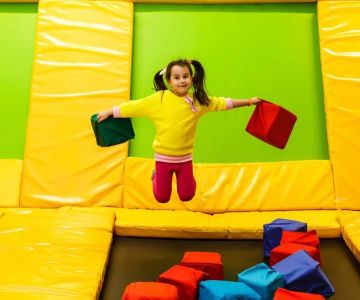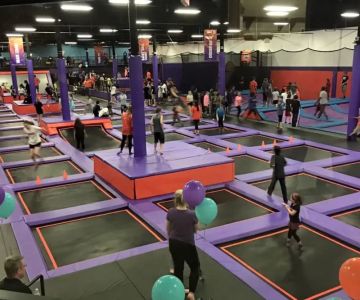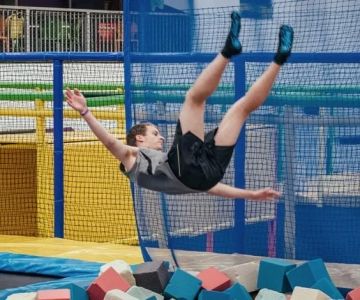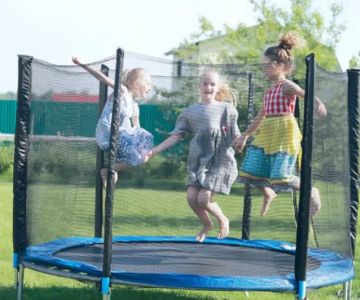- 1-Understanding-Double-Bounces-on-Trampolines
- 2-Importance-of-Timing-and-Coordination
- 3-Communication-Strategies-for-Partners
- 4-Practical-Exercises-to-Improve-Double-Bounce-Skills
- 5-Common-Mistakes-and-How-to-Avoid-Them
- 6-Real-Life-Success-Stories-from-Double-Bounce-Enthusiasts
- 7-How-Trampoline-Zone-Supports-Skill-Development
1. Understanding Double Bounces on Trampolines
Double bouncing involves two people coordinating their jumps on a trampoline to maximize height and control. Unlike solo bouncing, it requires precise timing, trust, and rhythm between partners. Mastering this skill enhances the fun and expands the range of tricks and movements possible on the trampoline.
Understanding the physics behind how the bounce of one person affects the other is key to improving double bounce techniques.
2. Importance of Timing and Coordination
Timing is everything when it comes to double bounces. Both jumpers must synchronize their movements so that one’s downward momentum adds power to the other’s upward bounce. Poor coordination can lead to uneven bounces or accidents.
Practicing together and developing a sense of rhythm is essential. Counting beats out loud or using visual cues can help partners stay in sync.
3. Communication Strategies for Partners
Clear communication is crucial before and during double bouncing. Partners should discuss their bounce style, comfort levels, and signals for starting or stopping. Using simple phrases like “ready,” “jump,” or “slow down” ensures safety and smooth coordination.
Building trust through open dialogue reduces hesitation and boosts confidence in executing complex bounce sequences.
4. Practical Exercises to Improve Double Bounce Skills
Start with basic exercises like synchronized low bounces to get used to timing. Gradually increase the height as partners gain confidence. Drills focusing on knee bend, arm movement, and landing posture improve control and stability.
Incorporate video recording to analyze performance and identify areas for improvement. Consistent practice is the key to mastery.
5. Common Mistakes and How to Avoid Them
Common errors include jumping out of sync, bending knees too late, or failing to communicate effectively. These mistakes can lead to awkward landings or injuries.
Avoid these by practicing regularly, using safety gear, and setting clear expectations with your partner. Patience and persistence will help overcome early challenges.
6. Real-Life Success Stories from Double Bounce Enthusiasts
Many trampoline users have shared how mastering double bounces transformed their trampoline experience. For example, siblings who initially struggled with timing found that daily practice and positive communication led to impressive jumps and new tricks.
These stories highlight the importance of teamwork and dedicated practice in achieving trampoline goals.
7. How Trampoline Zone Supports Skill Development
Trampoline Zone offers expert resources, quality trampolines, and accessories designed to enhance safety and performance for double bouncing. Their community and instructional content provide valuable tips for beginners and advanced jumpers alike.
By exploring products and advice from Trampoline Zone, you can elevate your double bounce skills and enjoy a safer, more thrilling trampoline experience.







 Nova Trampoline and Adventure Park4.0 (183 reviews)
Nova Trampoline and Adventure Park4.0 (183 reviews) Urban air3.0 (14 reviews)
Urban air3.0 (14 reviews) Get Air Trampoline Park4.0 (1262 reviews)
Get Air Trampoline Park4.0 (1262 reviews) Jump And Party4.0 (39 reviews)
Jump And Party4.0 (39 reviews) Frankie's of Greenville4.0 (4669 reviews)
Frankie's of Greenville4.0 (4669 reviews) Axtion Air Jump & Sports Trampoline Park4.0 (824 reviews)
Axtion Air Jump & Sports Trampoline Park4.0 (824 reviews) Are Trampoline Parks Safe for Kids? Essential Guide for U.S. Parents
Are Trampoline Parks Safe for Kids? Essential Guide for U.S. Parents How Often Should You Replace Trampoline Springs? Tips for Proper Maintenance
How Often Should You Replace Trampoline Springs? Tips for Proper Maintenance How Much Is a Trampoline? A Detailed Guide to Trampoline Costs and Buying Tips
How Much Is a Trampoline? A Detailed Guide to Trampoline Costs and Buying Tips Bounce Techniques for Stronger Legs: Effective Exercises and Tips
Bounce Techniques for Stronger Legs: Effective Exercises and Tips Essential Music Gear for Trampoline Dance: Complete Guide
Essential Music Gear for Trampoline Dance: Complete Guide Fun STEM Experiments Using Trampolines to Spark Curiosity and Learning
Fun STEM Experiments Using Trampolines to Spark Curiosity and Learning